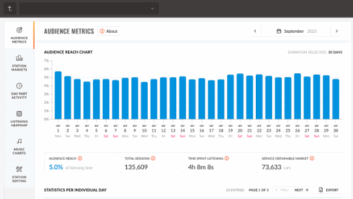Sony’s latest offering in the MiniDisc market is a cut above the consumer portables that have become a radio field recorder standard.
The MZ-B50 is billed as a “business recorder” and replaces the popular MZ-B3. Like its predecessor, the MZ-B50 incorporates a built-in microphone and speaker.
The new unit distinguishes itself with the latest upgrade to the ATRAC codec and its controls, which are a vast improvement over the mini portables. It is still not quite the fantasy digital recorder, but is a long step toward it.
Ahead of its time?
The previous business recorder, the MZ-B3, was released just before the big boom in MD. It was pricey at $995 list, and had an earlier codec than the CD-quality ATRAC 4.x that finally sparked major attention for the format.
Still, it was a solid, reliable recorder and gained currency with broadcasters.
While interesting, the high price and middling sound quality of the MZ-B3 took backstage to the smaller, cheaper units that soon followed. My point of reference with consumer MiniDisc recorders is the Sony MZR-55 that I have carried around for the past two years. This is one of the first “MD Jacket” sized units — barely larger than the MD media itself.
The downside here is that miniaturization had reached the point of diminishing returns. The controls were too small. Aside from the most obvious functions, many important controls were accessed through not-so-intuitive menus. Having the manual along was key.
Less fumbling
The controls on the MZ-B50 are almost exactly what I would have wished for after endless fumbling with the MZR-55. Part of this is possible simply because there is more real estate with the bigger form factor.
Beside the fact that the buttons are larger, two key menu-driven commands are actual control buttons: Erase and record mode (stereo/mono) functions are now mounted on a button and a two-position switch.
Making mono recordings with the menu mode is a total hassle. After setting the recording on pause, one must toggle through the menu to set it. Here, the option for double-length recordings is set before you even get started.
Also, erasing to clear a track or to make a fresh disc with the earlier MZR-55 requires going through numerous prompts. Now on the new unit, a single button saves much effort. At first, I was concerned that this could make recordings vulnerable. The unit has sufficient warning prompts to protect from accidental erasure.
Other additions here include improved cuing and search capabilities. A double speed playback allows for skimming through a recording. The Easy Search function jumps forward or backward in one-minute increments.
If you are not snapping in track marks during a recording session, finding sound bites in lengthy recordings can be a daunting task.
The cue/review basically is a fast forward/reverse control, but without the feel of working a cassette. Hitting the cue/review button does not bring instant gratification. There is a pause of a few seconds while the audio information is loaded for quick review.
For all the advantages of digital, jumping back and forth looking for a splice is still somewhat cumbersome.
The MZ-B50 is about twice as large as the smallest recorders. This increase is marginal when compared to the older MZR-55 with the attached battery pack.
This screw-on accessory holds two AA batteries and is a necessary enhancement to the tiny rechargeable incorporated into the case. The MZ-B50 simply includes the two AA cells in the body.
Battery life seems completely adequate. It made it through a 4-hour-plus recording test on a single recharge of NiMH batteries.
The larger size of the MZ-B50 is attributed to the built-in speaker/stereo microphone. The mic is geared for business recorder applications. The quality is fine for documenting a business meeting or interview for print with a voice-operated trigger to start recordings.
As with most integrated microphones, it is really not broadcast-quality. The speaker is welcome as it allows checking a recording without having to hook up headphones. For all these increases in size and features, the unit weighs less than 8 ounces without batteries.
The only marks against the MZ-B50 are the 1/8-inch jacks, the absence of a manual recording level setting and the limited remote control. Yes, the 1/8-inch jacks are, in and of themselves, not a problem. But the plug-in power for cheap electret mics is a serious issue when using dynamic microphones.
Aside from generating a noticeable hiss, jiggling the connector can spoil a recording by sparking snaps and crackle.
Sony is considering making a special connector in forthcoming pro versions of the MZ-B50. In the meantime, fabricate your own special XLR-to-1/8-inch cable with DC blocking capacitor to work around this. There is no such workaround for setting levels. While the automatic recording level setting is actually pretty good, it is nice having the option of doing this manually.
As it is, the only option here is the two-position mic sensitivity switch. It would be terrific if a manual control emulating an analog recorder’s jogwheel were built in. Also, a backlighting option to the display would be helpful too.
Also on my wish list is a full-function remote control. As it is, the wired remote only controls playback. Being able to start, stop and/or pause a recording with it would be nice. Mysteriously, the three-volt AC adapter is not included in the kit. Better to trade the cheesy headphones supplied with it for that.
Despite some shortcomings, the MZ-B50 is far more field-friendly than the tiny consumer portables. Obviously, it does not have near the amenities that the full-sized pro recorders do.
This unit lies about halfway between those ends of the spectrum and will no doubt appeal to many radio reporters. I like it enough that it has replaced the MZR-55 as my primary field recorder.
Price: $599.95
For more information from Sony, call (800) 222-7669, or visit www.sony.com on the World Wide Web.







